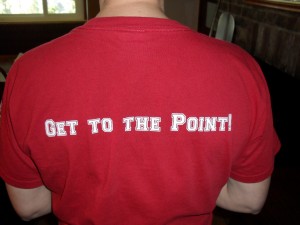
“Get to the Point!” is great advice on two levels:
1. If you’re in the San Francisco Bay Area, “the Point” is the nickname for Pt. Isabel, the country’s largest off-leash dog park.
2. Wherever you are, if you get to the point quickly, you achieve these three benefits:
- Convey your message the first time (or at least the second or third time….).
- Are easy to work with, which makes you a more valuable colleague.
- Are more credible and trustworthy.
So what are the best ways to get to the point?
One of my favorites is to speak in headlines. Figure out what the core element the individual you’re talking to wants to know. Then compose your main idea along with the three most salient points. After you get a reaction, you can determine whether you need to tell the full story. This tool can help you create verbal headlines that are concise, cogent and compelling.
Another way is to use Plain Language in Plain English, which is the name of a wonderful new book. Cheryl Stephens and her 18 international contributors have compiled a comprehensive toolkit for anyone who wants to communicate clearly.
And computer programs are also available now too, especially in health care.
As for the book, it covers tips on understanding your audience, structuring your documents, writing, rewriting (of course!), checking for bias, and testing your writing.
The book’s test chapters were eye opening for me, especially since I’m most familiar with the basic Flesch Reading Ease and Flesch-Kinkaid Grade Level included in Microsoft Word®, which many people don’t even know about. (You have to turn the tests on to use them as part of spell check.)
For example, the book covers many other readability tests that assess how easy your text is to read as well as how interesting it is. Some of the newer tests are the Bog Index, the SMOG calculator, and the Strain and Mist Index.
And there’s more! The section on literacy task analysis, which is a relatively new test, explains how you can evaluate the ease by which your readers can complete the tasks included in your document. In other words, can they accurately complete the form you developed? The test measures the type and extent of thinking readers must do to complete the problems presented in your document. Very cool!
In an ideal world, you need a three-person work group to create the clearest, most usable documents, one of the book’s contributors maintains. The trio is a content expert, a writer, and a graphic designer. When that’s not possible (which is most of the time, I say), you need to think about what the missing expert would do in your situation.
Plain language can be a life and death situation. For example, several academic studies have examined the problems of poor health literacy and the effects on patients’ health, health care costs, and outcomes.
In the United States, the new federal program, Health Literacy Action Plan, promotes using simplified language.
Healthwise, a nonprofit provider of health information, is a great example of simple language in action. Healthwise has introduced online programs, called virtual conversations. They ask patients about their symptoms. Then based on the individuals’ answers, the programs review options individuals should consider. The conversations try to avoid medical jargon and terminology.
Check out the back-pain program, which won the 2010 Grand ClearMark Award from the Center for Plain Language, at http://www.healthwise.org/backconversation/.
So stop lifting heavy things (including weighty words) and beating around bushes. Join me at the point!

0 Comments